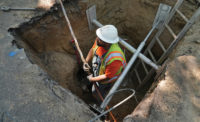Drinking Water
EPA to Release $9B Over Next Three Years for Lead Pipe Replacements

The $9 billion in IIJA funds will be distributed in $3 billion annual increments through the state revolving fund loan program.
Photo courtesy of U.S. EPA
The U.S. Environmental Protection Agency says it plans to distribute $3 billion annually over the next three years to identify and replace an estimated 1.7 million lead service lines across the U.S.
The funding, announced May 2, is authorized under the Infrastructure Investment and Jobs Act (IIJA) and will be disbursed through the drinking water state revolving fund loan programs in all U.S. states and territories, Biden administration officials said on a call with reporters.
“The science has been clear for decades: there is absolutely no safe level of lead exposure, especially not for our children,” said EPA Administrator Michael S. Regan on the call.
The IIJA authorized a total of $15 billion for lead service line replacements. The $9 billion in funding announced May 2 will be disbursed through state the revolving loan program territories and will build on the ongoing Lead and Pipe Action Plan and EPA’s Get the Lead Out program, which is partnering with 200 underserved communities to provide technical assistance in applying for state loans and grants as well as identifying and removing lead service lines.
Close to 50% of the funding will go to disadvantaged communities, with the formulas for allotments set to ensure that states with the greatest need receive funding first, Regan said.
The latest Drinking Water Infrastructure Needs Survey and Assessment estimated that there are more than 9 million lead services lines currently in use throughout the U.S. and that it could cost between $50 billion and $80 billion (in 2021 dollars) to remove them all.
In conjunction with the funding announcement, EPA released a memorandum for state agency officials to help them use the funding available to their best advantage. The funds can not only be used for identifying and replacing lead service line, but community education and engagement efforts, too related to the dangers of lead and the need for lead service line replacements.




